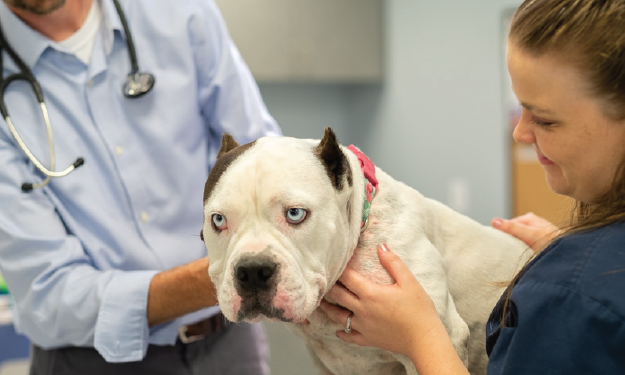Apocrine Gland Adenocarcinoma in Dogs

What is Apocrine Gland Adenocarcinoma of the Anal Sac?
Anal Gland Adenocarcinoma is a cancer of the apocrine gland, located inside of the anal sac. Canine anal glands are scent glands that produce an oily secretion. They are found on either side of the dog’s anus between the internal and external sphincter. These tumors tend to be locally invasive and can metastasize early. However, this cancer is associated with a prolonged clinical course. Breeds more commonly affected include English Cocker Spaniels, Cavalier King Charles Spaniels, German Shepherds and English Springer Spaniels. Both genders of dogs are equally affected. The cause of this tumor is unknown.
What are the Clinical Signs?
Many dogs with this tumor have no sign of disease until the tumor is very large. Clinical signs reported include straining to urinate or defecate, pain on defecation, blood in the stool and changes in stool size. The only clinical sign in many instances is a swelling of the area around the anus called the perineum. Hypercalcemia (elevated blood calcium) occurs in approximately 25% of cases and if present is associated with the following clinical signs – lethargy, hind limb weakness, increased urination and increased thirst.
How is it Diagnosed?
Many times, anal gland tumors are picked up incidentally on physical examination performed at your dog’s annual or semi-annual veterinary visit. When your veterinarian finds a mass in your dog’s anal gland it is important to differentiate it from infection or inflammation. A definitive diagnosis can be made with a fine needle aspirate or biopsy of the tumor. To determine if and where the disease has spread, staging is recommended. This includes blood work (CBC/Chemistry Profile), thoracic radiographs and an abdominal ultrasound. A CT scan or MRI of the abdomen may yield a more complete picture of disease spread. Lameness or bone pain should be further evaluated with imaging. This disease is often associated with hypercalcemia (elevations in blood calcium level) that can cause permanent damage to the kidneys and other vital organs, impacting your pet’s quality of life.
What is the Treatment?
Treatment options presented will depend on the results of the staging tests. Options may include surgery, radiation, and/or chemotherapy. The best long-term outcomes have been afforded to dogs that receive multi-modal therapy (surgery, radiation and/or chemotherapy).
- Surgery: Removing the primary tumor often is the first step in treating this disease. The hope is that in removing the primary tumor in the anal sac and, if involved, the intra-abdominal regional lymph node(s), survival time and quality of life will be significantly improved. Surgery to remove the lymph nodes may be difficult and is associated with an increased chance of bleeding perioperatively. Unfortunately, in many instances the primary tumor is not found until it is very large, making surgery not feasible.
- Radiation: Radiation therapy is often discussed as adjuvant therapy after surgery to prevent or delay tumor recurrence or as a primary way to control your pet’s local disease if he/she is not a surgical candidate. Due to the location of the tumor, aggressive surgery with wide margins is not possible in many circumstances, leaving behind microscopic disease. Definitive radiation (15-17 treatments) is recommended post-operatively and targets residual cancer cells in the hope of decreasing the chance of local recurrence. On the other hand, the use of palliative radiation (5-6 treatments) may stabilize a non-resectable mass and decrease clinical signs associated with the tumor’s size for a period of time.
- Chemotherapy: Systemic treatment with chemotherapy is warranted with this cancer due to the propensity to spread to distant sites (ie local lymph nodes, lungs, liver, spleen and bone). The goal of chemotherapy is to decrease the risk of disease spread and/or stabilize current spread. Drugs often used include mitoxantrone, doxorubicin and carboplatin.
What is the Prognosis?
Prognosis depends on many factors. There are four clinical stages that have prognostic importance. The staging system is based on the primary tumor’s size, presence and size of the regional (sublumbar lymph nodes) metastasis and the presence of distant metastasis. Overall, the average survival time reported in the literature for dogs with all stages of anal gland adenocarcinoma is approximately 15-18 months. Dogs with a small tumor and no distant or regional spread can expect to live years with treatment. However, as the size of the tumor increases and with evidence of regional or distant spread, the average survival time decreases. Those patients that are amenable to surgery, radiation and/or chemotherapy appear to have the longest overall survival. Patients that undergo therapy directed at palliation, including palliative radiation and chemotherapy can see an improvement in clinical signs for as long as one year.